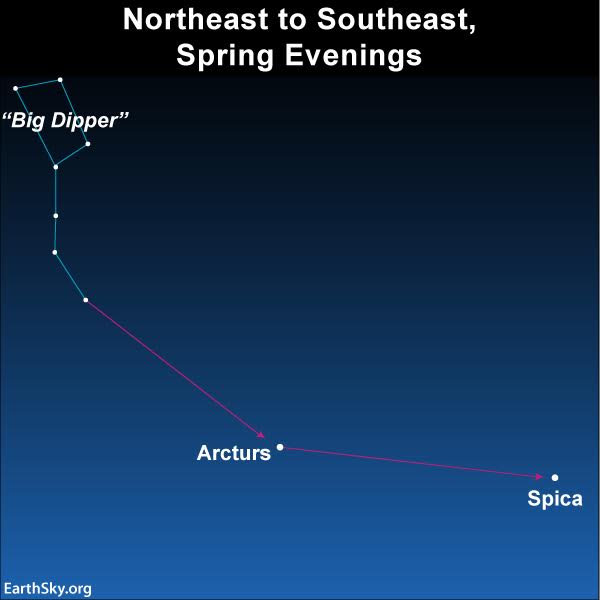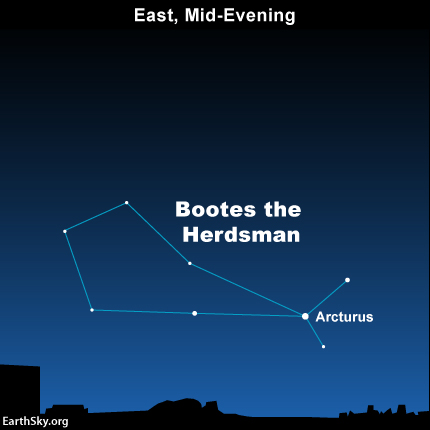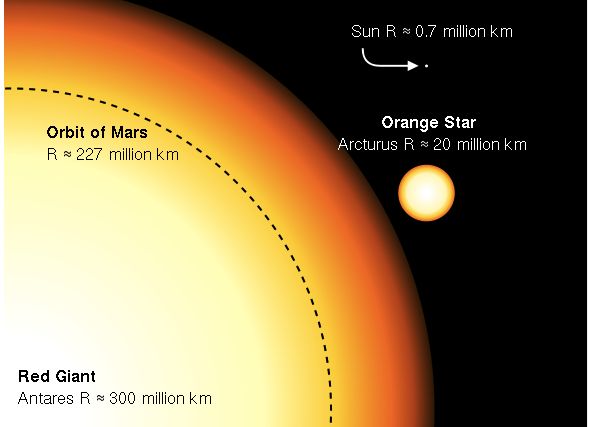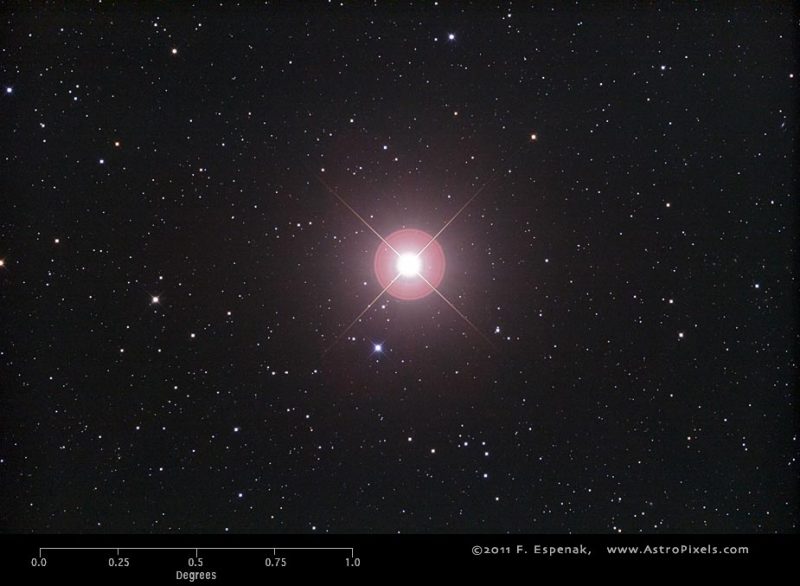

The star Arcturus is easy to identify. Use the Big Dipper to “follow the arc to Arcturus” and “drive a spike Spica.” Read more.
Arcturus is the alpha star of a cone-shaped constellation called Boötes the Herdsman. It’s far enough north on the sky’s dome that – for Northern Hemisphere observers – it’s visible during some part of the night throughout most of the year. There’s an easy mnemonic for remembering how to identify this bright, orange star. Just remember the phrase: follow the arc to Arcturus.
First, locate the Big Dipper in the northern sky. Notice that the handle of the Big Dipper is a curve or arc. Extend this curve past the end of the Big Dipper’s handle, and you will come to Arcturus.
You might notice bright orange Arcturus passing high overhead on late spring evenings. In summer, Arcturus is high overhead shortly after dark. Autumn observers need to look early because then it sets by mid-evening. The best time to observe it in winter is in the wee hours before dawn.
Our chart below shows the constellation Bootes as you stand facing south on spring evenings. Seeing a Herdsman in these stars might be difficult, but the constellation is easy to imagine as a kite.

Arcturus and its constellation Boötes the Herdsman. Boötes has the shape of a kite, and Arcturus is at the point where you’d attach a tail.
Arcturus is the brightest star north of the celestial equator. What does that mean? Imagine that Earth’s equator can be projected onto the sky. This line above Earth’s equator is called the celestial equator. It divides the sky into northern and southern hemispheres, just as Earth’s equator does for Earth. The three brightest stars of the sky – Sirius, Canopus and Alpha Centauri – are south of the celestial equator. Meanwhile, Arcturus is the brightest star in the northern part of the sky. It is only marginally brighter than the northern hemisphere’s second-brightest star, Vega. To the eye, Arcturus and Vega reign as co-stars in the northern half of the sky.

Johannes Hevelius drew Arcturus’ constellation Boötes in Uranographia, his celestial catalogue in 1690. The view is mirrored following the tradition of celestial globes, showing the celestial sphere in a view from “ouside.” Image via Wikimedia Commons.
History and mythology of Arcturus. Arcturus’ constellation Boötes – the Herdsman – is sometimes pictured as guarding the Great Bear, or Ursa Major, which contains the Big Dipper asterism. We sometimes hear Arcturus called the Bear Guard.
In China, the constellation for which Arcturus is the chief star was sometimes called the Dragon. In some classical Greek stories, Boötes was Icarus, who in another story flew too close to the sun. Passing directly over the Hawaiian Islands, Arcturus was a particularly important navigational star to the islands’ indigenous inhabitants and other Polynesians.
The translation may be questioned, but Arcturus is among the few stars mentioned in the Bible. (“Which maketh Arcturus, Orion, and Pleiades, and the chambers of the south” – Job 9:9 and “Canst thou bring forth Mazzaroth in his season? or canst thou guide Arcturus with his sons?” – Job 38:32, KJV.)
One interesting story about Arcturus relates to the 1933 Century of Progress Exhibition in Chicago. Its promoters wanted a flashy way to open the show, so they decided to have the light from Arcturus pass through a telescope onto a photocell. The photocell in turn worked as the switch that turned on the main spotlights to open the exhibition. There had also been a World’s Fair in Chicago in 1893, 40 years before the 1933 show. At the time, astronomers thought that Arcturus was 40 light-years away. So they thought that light left Arcturus at the end of the 1893 fair and traveled for 40 years through space like an Olympic torch bearer, to open the 1933 show.
The promoters of Chicago’s World’s Fair had a great idea, but today’s astronomers place the distance to Arcturus at just less than 37 light-years.

The red giant Arcturus is roughly 25 times the diameter of our sun. It’s not the largest of the red giants, however, as this diagram shows. Image via Wikimedia Commons.
Science of Arcturus. Arcturus is likely to be considerably older than our sun. When the sun evolves to become a red giant, the sun might be a star much like Arcturus is now.
Arcturus is roughly 25 times greater in diameter than our sun. Because of its larger size, in visible light Arcturus radiates more than 100 times the light of our sun. If you consider infrared and other forms of radiant energy, Arcturus is about 200 times more powerful than the sun. Its mass is hard to exactly determine, but might be slightly greater than that of our sun.
The reddish or orange color of Arcturus signifies its temperature, which is about 7,300 degrees Fahrenheit (4038 Celsius). That makes it several thousand degrees cooler than the surface of the sun.
The bright orange star Arcturus is especially noteworthy for its large proper motion, or sideways motion, on the dome of Earth’s sky. Only Alpha Centauri – our sun’s nearest neighbor among the stars – has a higher proper motion among the first-magnitude, or bright, stars in our stellar neighborhood. And of course the large proper motion of Alpha Centauri stems from the fact that it’s so relatively close to us.
In the meantime, what can the proper motion of Arcturus be telling us?
It tells us that Arcturus is actually moving at a tremendous rate of speed (122 km/second or 76 miles/s) relative to our solar system. Arcturus is thought to be an old star. It appears to be moving with a group of at least 52 other such stars, known as the Arcturus stream or Arcturus moving group.
From the vantage point of Earth, Arcturus is rapidly moving in a southern direction. It’s now at about its closest point to Earth and will vanish from visibility to the unaided eye when it reaches the Carina-Vela border in about 150,000 years.
Enjoying EarthSky so far? Sign up for our free daily newsletter today!
The position of Arcturus is RA: 14h 15 m 39.7s, dec: +19° 10′ 56″

Arcturus or Alpha Boötis (Alp Boo) is the brightest naked eye star in the constellation Boötes the Herdsman. Photo via Fred Espenak at AstroPixels.
Bottom line: Arcturus is a red giant star (it appears more orange to the eye), roughly 25 times greater in diameter than our sun. It’s easy to find if you “follow the arc to Arcturus.” That is, follow the curve in the Big Dipper’s handle until you spot this star.
from EarthSky https://ift.tt/2vUy1vk


The star Arcturus is easy to identify. Use the Big Dipper to “follow the arc to Arcturus” and “drive a spike Spica.” Read more.
Arcturus is the alpha star of a cone-shaped constellation called Boötes the Herdsman. It’s far enough north on the sky’s dome that – for Northern Hemisphere observers – it’s visible during some part of the night throughout most of the year. There’s an easy mnemonic for remembering how to identify this bright, orange star. Just remember the phrase: follow the arc to Arcturus.
First, locate the Big Dipper in the northern sky. Notice that the handle of the Big Dipper is a curve or arc. Extend this curve past the end of the Big Dipper’s handle, and you will come to Arcturus.
You might notice bright orange Arcturus passing high overhead on late spring evenings. In summer, Arcturus is high overhead shortly after dark. Autumn observers need to look early because then it sets by mid-evening. The best time to observe it in winter is in the wee hours before dawn.
Our chart below shows the constellation Bootes as you stand facing south on spring evenings. Seeing a Herdsman in these stars might be difficult, but the constellation is easy to imagine as a kite.

Arcturus and its constellation Boötes the Herdsman. Boötes has the shape of a kite, and Arcturus is at the point where you’d attach a tail.
Arcturus is the brightest star north of the celestial equator. What does that mean? Imagine that Earth’s equator can be projected onto the sky. This line above Earth’s equator is called the celestial equator. It divides the sky into northern and southern hemispheres, just as Earth’s equator does for Earth. The three brightest stars of the sky – Sirius, Canopus and Alpha Centauri – are south of the celestial equator. Meanwhile, Arcturus is the brightest star in the northern part of the sky. It is only marginally brighter than the northern hemisphere’s second-brightest star, Vega. To the eye, Arcturus and Vega reign as co-stars in the northern half of the sky.

Johannes Hevelius drew Arcturus’ constellation Boötes in Uranographia, his celestial catalogue in 1690. The view is mirrored following the tradition of celestial globes, showing the celestial sphere in a view from “ouside.” Image via Wikimedia Commons.
History and mythology of Arcturus. Arcturus’ constellation Boötes – the Herdsman – is sometimes pictured as guarding the Great Bear, or Ursa Major, which contains the Big Dipper asterism. We sometimes hear Arcturus called the Bear Guard.
In China, the constellation for which Arcturus is the chief star was sometimes called the Dragon. In some classical Greek stories, Boötes was Icarus, who in another story flew too close to the sun. Passing directly over the Hawaiian Islands, Arcturus was a particularly important navigational star to the islands’ indigenous inhabitants and other Polynesians.
The translation may be questioned, but Arcturus is among the few stars mentioned in the Bible. (“Which maketh Arcturus, Orion, and Pleiades, and the chambers of the south” – Job 9:9 and “Canst thou bring forth Mazzaroth in his season? or canst thou guide Arcturus with his sons?” – Job 38:32, KJV.)
One interesting story about Arcturus relates to the 1933 Century of Progress Exhibition in Chicago. Its promoters wanted a flashy way to open the show, so they decided to have the light from Arcturus pass through a telescope onto a photocell. The photocell in turn worked as the switch that turned on the main spotlights to open the exhibition. There had also been a World’s Fair in Chicago in 1893, 40 years before the 1933 show. At the time, astronomers thought that Arcturus was 40 light-years away. So they thought that light left Arcturus at the end of the 1893 fair and traveled for 40 years through space like an Olympic torch bearer, to open the 1933 show.
The promoters of Chicago’s World’s Fair had a great idea, but today’s astronomers place the distance to Arcturus at just less than 37 light-years.

The red giant Arcturus is roughly 25 times the diameter of our sun. It’s not the largest of the red giants, however, as this diagram shows. Image via Wikimedia Commons.
Science of Arcturus. Arcturus is likely to be considerably older than our sun. When the sun evolves to become a red giant, the sun might be a star much like Arcturus is now.
Arcturus is roughly 25 times greater in diameter than our sun. Because of its larger size, in visible light Arcturus radiates more than 100 times the light of our sun. If you consider infrared and other forms of radiant energy, Arcturus is about 200 times more powerful than the sun. Its mass is hard to exactly determine, but might be slightly greater than that of our sun.
The reddish or orange color of Arcturus signifies its temperature, which is about 7,300 degrees Fahrenheit (4038 Celsius). That makes it several thousand degrees cooler than the surface of the sun.
The bright orange star Arcturus is especially noteworthy for its large proper motion, or sideways motion, on the dome of Earth’s sky. Only Alpha Centauri – our sun’s nearest neighbor among the stars – has a higher proper motion among the first-magnitude, or bright, stars in our stellar neighborhood. And of course the large proper motion of Alpha Centauri stems from the fact that it’s so relatively close to us.
In the meantime, what can the proper motion of Arcturus be telling us?
It tells us that Arcturus is actually moving at a tremendous rate of speed (122 km/second or 76 miles/s) relative to our solar system. Arcturus is thought to be an old star. It appears to be moving with a group of at least 52 other such stars, known as the Arcturus stream or Arcturus moving group.
From the vantage point of Earth, Arcturus is rapidly moving in a southern direction. It’s now at about its closest point to Earth and will vanish from visibility to the unaided eye when it reaches the Carina-Vela border in about 150,000 years.
Enjoying EarthSky so far? Sign up for our free daily newsletter today!
The position of Arcturus is RA: 14h 15 m 39.7s, dec: +19° 10′ 56″

Arcturus or Alpha Boötis (Alp Boo) is the brightest naked eye star in the constellation Boötes the Herdsman. Photo via Fred Espenak at AstroPixels.
Bottom line: Arcturus is a red giant star (it appears more orange to the eye), roughly 25 times greater in diameter than our sun. It’s easy to find if you “follow the arc to Arcturus.” That is, follow the curve in the Big Dipper’s handle until you spot this star.
from EarthSky https://ift.tt/2vUy1vk

Aucun commentaire:
Enregistrer un commentaire